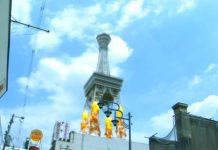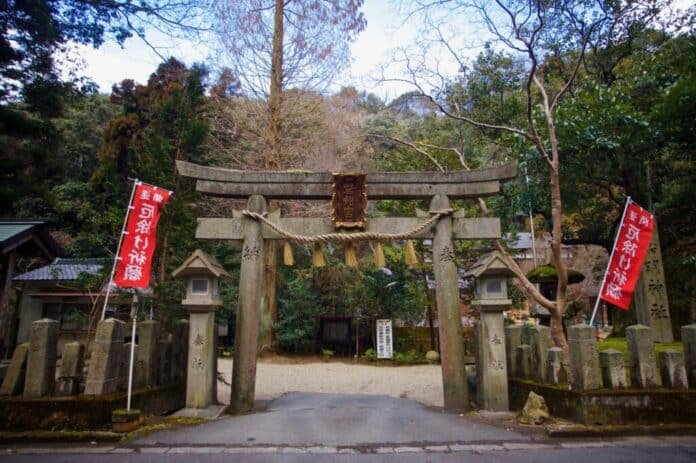
Osaka is full of nooks and crannies that locals, let alone guidebooks, don’t necessarily know nor mention. The area of Kisaichi in Katano City is one of the best examples of this. Appreciated by those in the know, it features many attractions that, for the most part, masses have spared.

Table of Contents
History and Geography
Located in the area where Osaka, Kyoto and Nara prefectures meet, it is no wonder that Katano City and the neighborhood of Kisaichi have a long history dating millennia. Kisaichi is where the mountains east of Osaka prefecture ascend when coming along the Amano River. This effectively delimited where new inhabitants could settle along the river. As a tributary of the Yodo River which connects Kyoto to Osaka and the Pacific Ocean, the area was settled early. The name of the river – The River of Heaven – is the Japanese term for the Milky Way, and it plays an important role in the culture of the area.

Archeologists discovered pottery from the Jomon Era (14,000 – 300BCE) in Katano, indicating settlers came to the area much before recorded history. The first nobility clan known to have lived in the area are the Mononobe. They settled there over 1500 years ago on their way to the Yamato region in Nara that was the capital at the time. They said that they descended from Nigihayahi, a protege of the Shinto Goddess of the Sun Amaterasu, who came down from the heavens on a stone ship. The Katano Mononobe Clan ruled the area and the Mori Tumulus dating from the 3rd and 4th century are believed to be those of the clan.
In later centuries, the imperial court designated the area as imperial hunting grounds. Life flourished in the area thanks to its fertile grounds, and as an entry road into Nara Prefecture. Rice for the production of sake was a big part of the economy, and visitors came to the region renowned for its cherry blossoms which line the Amano River.
Iwafune Shrine
Unless driving or wishing to hike out and back, most people start their excursion by taking the Keihan bus #18 from Keihan Katano-shi Station (交野市駅, ¥520 from JR Osaka) to Iwafune Jinja Mae bus stop (磐船神社前, ¥230). From there, walk over to Iwafune Shrine (Fri – Tue, 10:00 – 15:00), located a few minutes down the road. Please note that to visit the shrine, there is only one bus a day on weekends alone, at 10:30 a.m.
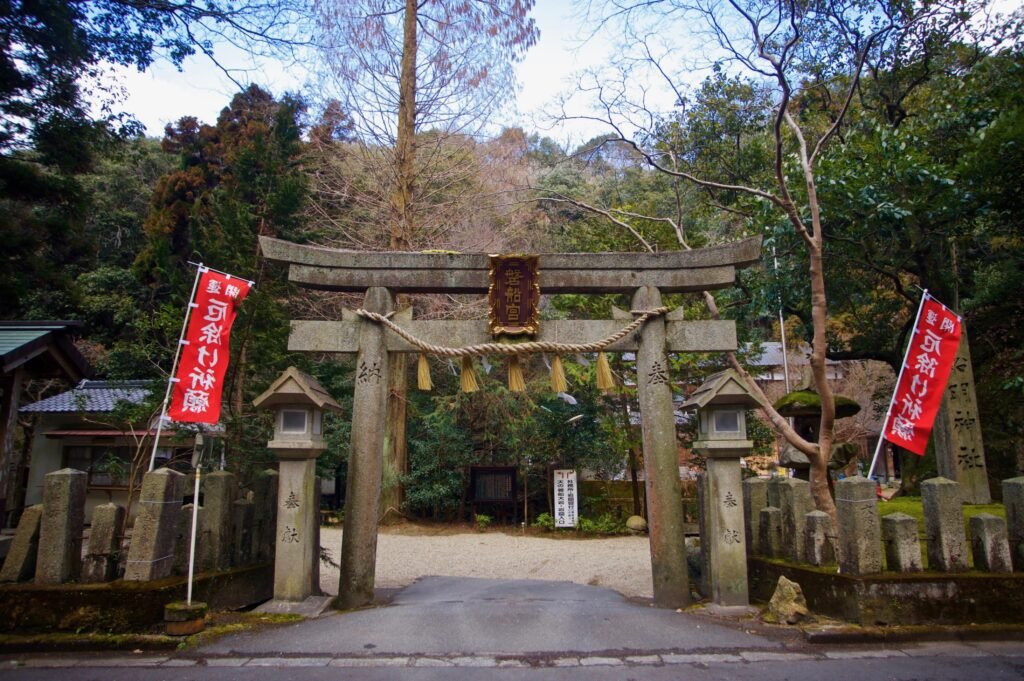
The Mononobe Clan founded the shrine back in the 3rd or 4th century according the most records. Later, the shrine was associated with Buddhist mountain asceticism (Shugendo), in particular through Sumiyoshi, the God of poetry and sea navigation. Unfortunately, floods destroyed most of the shrine and its treasures in the 18th century. However, dedicated locals kept some of the rituals going through the years. During the Meiji Era (1868-1912), the shrine was restored, keeping its syncretic relation between Shinto and Buddhism. This is a somewhat rare occurrence, as the two were officially separated at the time of the Meiji Restoration.
The shrine is centered around the main sacred rock, named Ama-no-Iwafune, or the Heaven’s Rock Ship. The rock evokes the ship Nigihayahi boarded when he descended from the heavens. It measures 12m by 12m and is centrally located on the grounds. It is on the banks of the Amano River, which spills into the Yodo River 10km downstream in the town of Hirakata. An ancient road was built along the river to connect Hirakata to Nara prefecture. Its history seemingly predates the Yamato Era 250 – 710CE.



The shrine stands out – or under as the case may be – from others by having a long and sinuous spelunking section under large boulders and in caves. Access to that section of the shrine costs ¥500 (tickets from the main building) and is called “Gankutsu Meguri”, or Tour of the Caves. Arrows point in the right directions, but it will be challenging physically for most people. It is a nice metaphor for the path of enlightenment. Mountain ascetics used the grounds for religious practice as part of their training. For today’s visitors, the underground altars are a nice reward at the end of the journey. Once out of the caves, you will pass by several other altars, before coming back to the main building. From the shrine, continue down the road to the right for a few hundred meters until the red torii gate on your left. If you wish, you can go through it to see from up close a waterfall dedicated to meditation.
Hoshida Park
Just after the torii gate is the entrance to Hoshida Park. Regardless of the season, you will probably break into a sweat while climbing the steep road. The path leads you to the most famous attraction in the city, the Hoshino Suspended Bridge (09:30 – 16:30, closed around New Years, free). Spanning 280 meters with a maximal height of 50 meters, the wobbling yet solid bridge is not for the faint of heart. It provides a spectacular view over a sea of green unlike very few places. Come later in the year, and the greens turn to their warm autumnal coat, though be warned that it can get especially crowded then.
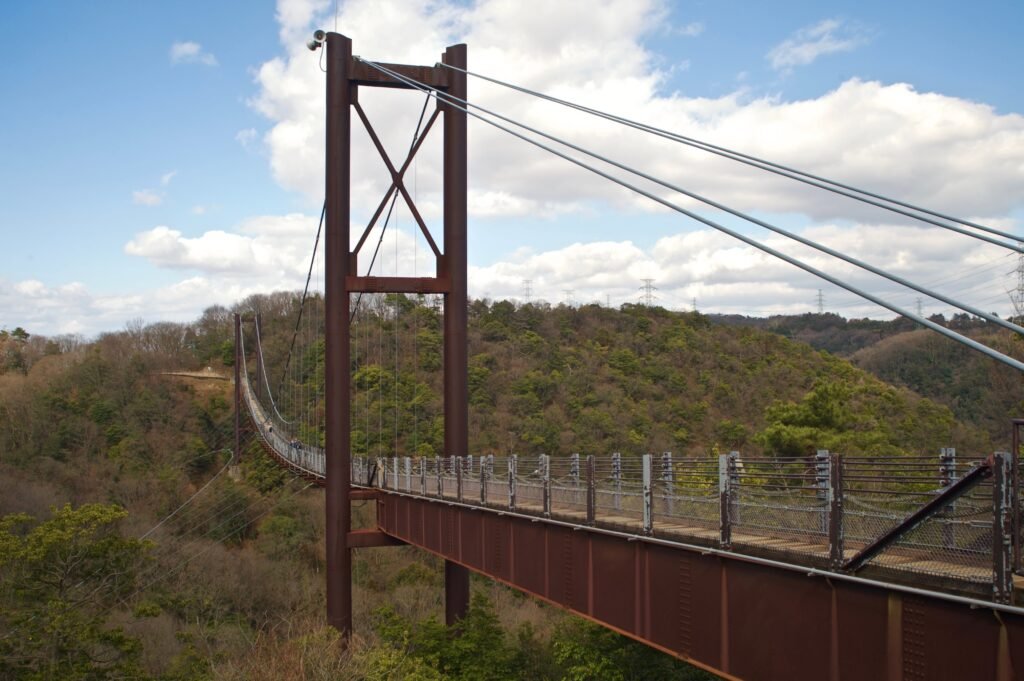
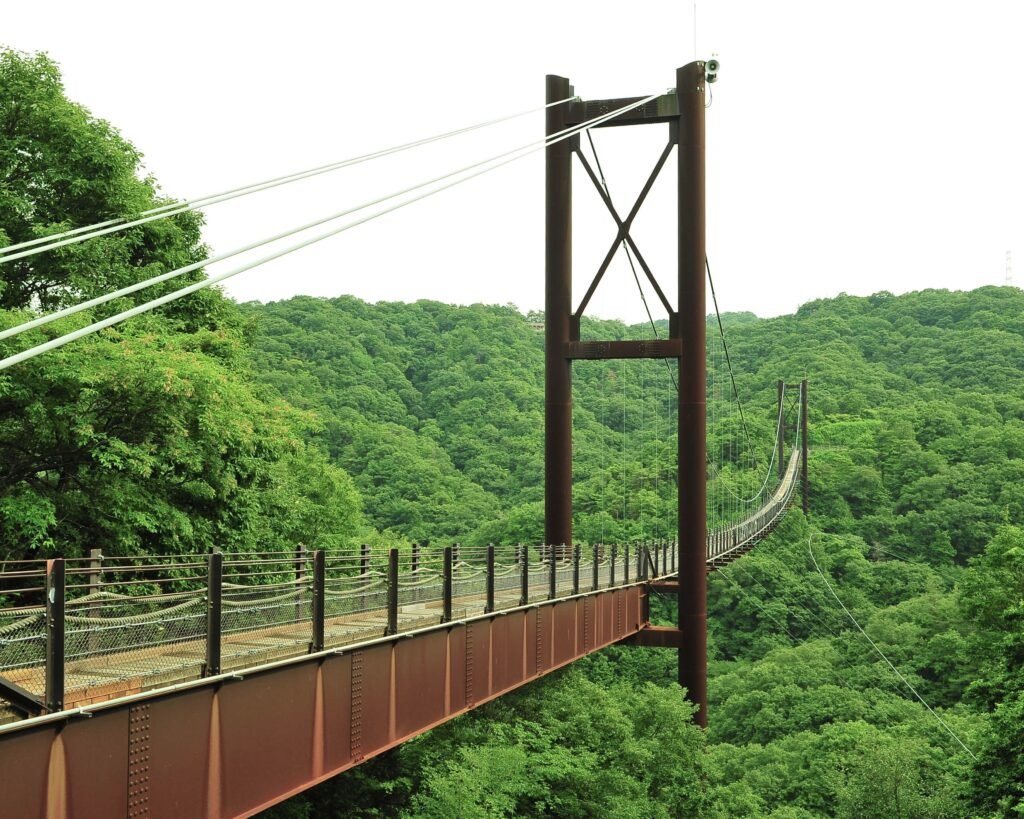
The rest of the park also features numerous and relatively easy and well-marked hiking paths, with several maps located along the way. Some courses offer other viewpoints, follow lively streams where some wildlife can be observed (mostly reptiles and insects), and you may even encounter the illustrious Hamburger Rock.
Coming down from the suspension bridge, you will find the park’s guest reception building, and opposite is a towering climbing wall. It measures over 16 meters and is suitable for climbers of all levels. Classes are available to learn and improve your climbing skills, though they are only offered in Japanese. For safety reasons, you need some Japanese ability to access the wall as well, and phone bookings are required (072-891-0110).

From there, follow the signs back towards Kisaichi Stn. (私市駅). The path goes through the trees before arriving at the park’s car lot (¥200/hr, gets full early on busy days, in particular in fall). The path then follows the same river from Iwafune Shrine, the Amano River, before arriving at the Iwafune-shizen-no-mori Sport Bunka Center where you can have a BBQ. From the park’s reception to the station, the hike takes approximately 45 minutes at a leisurely pace.
Botanical Garden & Old Town Meandering
If you came from Hoshida Park, right after crossing the river pass the Sport Center you will find a little path to the left that goes through the Riverfront Plaza (水辺プラザ). Follow it and you will end up at a bridge going into the Osaka Public University Botanical Garden ( 9:30 – 16:30, Tue – Sun, ¥350 for High Schoolers and older). The outdoor garden features various ecosystems and plant life sections, from Japanese forests to magnolia gardens, Australian flora and so on. This ensures that whatever season you visit it, you will have an enjoyable experience.



After the garden, head back to road 168, and after crossing the traffic light (where there is also a bus stop to go the shrine, if you preferred coming this way), you have two options: either walk straight to get to Keihan Kisaichi Station (京阪私市駅), or take a left at the first street after the traffic light. Doing so you will end up in a proper Kisaichi where time seems to have stopped at least a few decades ago. Meander in the narrow streets, enjoy the little shrines, temples and parks, pass some fields and slowly make your way towards Keihan Kawachimori and JR Kawachi-Iwafune. With a bit of luck, you might even pass a hops field attended by the Osaka Public University, whose produce are used by a small brewery in downtown Osaka.
Kurondo Park & Katano Rock
The city has another large nature park called Kurondo Nature Park. It exudes a more natural atmosphere and rustic installations. Available features include BBQ areas, a pond with paddle boats and diners, some small waterfalls, and trails with more wildlife. Many of the paths have signs with various names, and it can get a little confusing if you don’t know the way. They also feature more wildlife, like the long tailed copper pheasant, which makes it popular not only with hikers, but also with bird watchers. Grabbing a map at the Kurondo Park Rest Area on the main path about 45 minutes from Kisaichi Station may be a good idea. If you are not taking the bus to Iwafune Shrine, there is a path leaving the rest area through a golf course, down its access road, that will bring you to the shrine.




On the other hand, if you head north in the Kurondo Park, you could follow the Osaka Nature Loop Trail (おおさか環状自然歩道 or Oosaka-kanjou-shizen-hodou) and climb Mt. Katano. The hike up is fairly steep at times, but at the top, you are rewarded with an outstanding 360° view, allowing you to observe the prefectures of Osaka, Kyoto and Nara atop a huge rock formation called the Katano Rock. When coming down the mountain, you can with backtrack, or continue along the Osaka Nature Loop Trail onto either JR Tsuda (津田) or JR Fujisaka (藤坂) stations. Should you decide to go on this hike, it is recommended to have a map. The two most popular online ones are Yamap and Yamareco. Yamareco tends to have more detailed maps with its subscription-only service, while Yamap also has a basic free service. Both are worthy services if you wish to explore Japanese trails extensively.
Daimon Sake Brewery
After all of this walking, you might develop a thirst, and visiting the Daimon Sake Brewery near Keihan Kawachimori Station or JR Kawachi Iwafune Station is an excellent option. Philip Harper worked at this brewery on his way to becoming the first foreign master brewer (tōji) in Japan. He eventually moved to Tamagawa brewery in northern Kyoto, as there can only be one master per brewery, and masters are in shortage. Daimon is the only brewery in the area still using flowing mountain water at the core of their production.




English tours are available upon request, and every Saturday and Sunday (except summer) there are public tours from 11:00 which cost ¥1500, including tastings. Private tours for 4 people or more can also be arranged at other times, with options to dine at the annexed restaurant which specializes in seasonal dishes. Please note that at the time of writing, due to COVID-19 restrictions, these tours and restaurant may not be available. Best to contact the brewery ahead of time should you wish to visit the brewery. There is a small shop in the parking lot open on weekdays to purchase bottles directly, as well as an online shop.
Amano River Tanabata Festival
To finish the day, at the end of July, the city of Katano organizes the Amano River Tanabata Festival. Tanabata is a traditional summer festival and it celebrates the reunion of Orihime and Hikoboshi (Vega and Altair respectively), usually separated by the Milky Way (Amano-kawa, River of the Heavens). Traditionally celebrated on July 7th, people write wishes on colorful paper and hang them from bamboo poles.
Here, however, the festival takes place on the last Saturday of July. It features rows of lanterns painted by locals, aligned and arranged in various patterns along the Amano River at the aforementioned Riverfront Plaza near the botanical garden. As with many summer festivals, you will find plenty of food and game stalls, mostly near Kisaichi Stn. and the aforementioned Sport Center. The atmosphere is lively and friendly, with many visitors sporting yukata, summer kimono.





Dining Options and Conclusion
Restaurant options are more plentiful around JR Kawachi-Iwafune than Keihan Kisaichi, should you decide to stay for dinner, though there are some options near the latter, such as the cafe adjoining Sotoaso, the local outdoor store specialized in trail running and hiking gear.
Katano and Kisaichi are a great destination for anyone with a taste for the outdoors and culture. The area is easily accessible by public transportation, but also by car or bicycle (if you have the legs). The majority of hiking paths are walkable for anyone from toddlers through seniors, though some sweet bribes may be required for the former. Spring and autumn are most recommended in terms of natural vistas, but this also means that they are the busiest. I have personally enjoyed it in all seasons, and I believe you will too. Regardless of where you decide to wind down, after such a day, you will have no problem floating into sleep.















